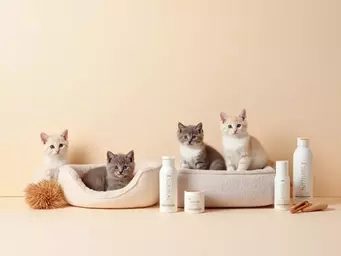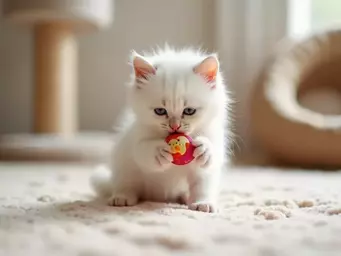Kitten Safety Hazards at Home

Posted on: 2025-11-11
By: Edyta Drabek
As a new kitten parent, understanding the safety hazards in your home is crucial for creating a secure environment for your furry friend. Here’s what you’ll learn to keep your curious little explorer safe!
What You Will Learn
- How to identify and remove choking hazards, such as small objects and cords.
- The importance of securely storing household chemicals and toxic items.
- Tips for creating a safe space, including securing windows and furniture.
- Strategies for maintaining vigilance as your kitten grows, including regular safety checks.
Kitten Home Safety Checklist & Expert Advice
Ensuring your home is a safe haven for your new kitten involves addressing common hazards and adopting proactive strategies. This visual guide highlights critical safety areas and expert recommendations.
Common Hazards
Kittens are curious. Identify and mitigate household risks:
- Small Objects: Choking hazards (coins, buttons, hair ties, small toys).
- Sharp Items: Store scissors, knives out of reach.
- Electrical Cords: Tempting to chew, cause injury.
- Toxic Plants: Replace with pet-safe varieties.
- Chemicals/Medications: Securely stored.
Protection Strategies
Proactive measures create a secure environment:
- Kitten-Proofing: Remove small objects, secure cords.
- Secure Storage: Use child-proof locks for cabinets.
- Trash Cans: Use secure lids to prevent access.
- Safe Spaces: Minimize risks from open windows, unsecured furniture.
- Ongoing Vigilance: Regularly reassess home for new hazards.
Expert Advice & Resources
Access guidance for optimal kitten care:
- Veterinarian Consults: Schedule routine check-ups.
- Online Resources: Utilize webinars, trusted guides.
- Community Engagement: Share experiences with other pet parents.
- Travel Precautions: Use sturdy carrier, secure in vehicle.
- Never Leave Unattended: Especially in parked cars.
Vigilance is Key!
Your kitten's safety is a continuous commitment.
Understanding Kitten Safety Hazards at Home
As a new kitten parent, ensuring kitten safety in your home is a top priority. These curious little furballs are known for their adventurous nature, which means they can get into trouble faster than you can say “catnip!” Understanding the safety hazards present in your home can help you create a secure environment for your new friend. At Kittie Care Central, I’ve seen firsthand how proactive measures can prevent accidents and keep kittens safe. For more comprehensive information on pet safety, you can refer to guidelines from the CDC Healthy Pets website.
It’s essential to recognize that kittens are not only playful but also prone to exploring every nook and cranny. By prioritizing their safety, you are taking the first steps to ensure their well-being and happiness at home. Ready to delve into the common hazards lurking around your house?
Why Kitten Safety Should Be a Priority for Pet Owners
Every kitten owner should be aware of their responsibility to keep their furry companions safe. Think of your kitten as a little explorer, ready to discover the world! This exploration can lead to dangerous situations without proper precautions. Here are a few reasons why kitten safety should be at the forefront of your mind:
- Prevention of Accidents: By knowing potential hazards, you can take steps to avoid accidents.
- Health Risks: Many household items can be toxic or harmful, leading to serious health issues.
- Peace of Mind: A safe environment allows you to enjoy your time with your kitten without constant worry.
When you understand the importance of kitten safety, you can enjoy your new pet without fear of accidents or injuries. Let’s take a closer look at some common hazards that may be right under your nose! Additionally, reports like the Cats Protection UK Annual Report highlight the ongoing need for responsible pet care, including safety measures.
Common Hazards in a Home Environment
While your home may seem like a safe haven, it can harbor numerous risks for your kitten. Identifying these hazards is key to kitten-proofing your space effectively. Here are some common dangers you should be aware of:
- Small Objects: Things like coins, buttons, and rubber bands can easily become choking hazards.
- Sharp Items: Scissors, knives, and other sharp tools should be kept out of reach.
- Electrical Cords: These are not only tempting for kittens but can also lead to serious injuries if chewed on.
Being proactive is vital! By recognizing these common hazards, you can take steps to eliminate risks and create a safer environment for your kitten. Now, let’s dive deeper into identifying hidden dangers!
Identifying Hidden Dangers: Small Objects and Sharp Items
Small objects often go unnoticed but can pose significant dangers to a curious kitten. Kittens love to explore with their mouths, so items that seem harmless to us can quickly turn into choking hazards for them. Here are some items to keep an eye on:
- Coins and buttons
- Hair ties and rubber bands
- Small toys or toy parts
- Jewelry and other accessories
Additionally, sharp items such as scissors and knives should be stored in cabinets or drawers that are not accessible to kittens. Taking these simple precautions can save you a lot of stress and keep your kitten safe!
Pro Tip
Did you know? Kittens are naturally curious and often explore their environment using their mouths. To enhance your kitten-proofing efforts, consider conducting a thorough sweep of your home every few weeks to identify new hazards as your kitten grows. This proactive approach not only keeps your kitten safe but also helps you stay one step ahead in ensuring a secure environment!
Summary of Kitten Safety Hazards and Protection Strategies
As a first-time kitten parent, keeping your little furball safe is top priority! Understanding the various hazards in your home is essential to ensure a secure environment for your new feline friend. Let's recap some of the key safety measures we discussed to create a safe haven for your kitten.
- Identify and remove potential choking hazards, such as small objects and loose cords.
- Keep household chemicals securely stored, out of reach of curious paws.
- Be mindful of toxic plants, replacing them with pet-safe varieties.
- Use child-proof locks on cabinets and secure trash cans to prevent unwanted access.
- Create a safe space by minimizing risks associated with open windows and unsecured furniture.
By implementing these strategies, you can significantly reduce the risks your kitten might encounter. Remember, vigilance is key, and keeping an eye out for new potential hazards will help foster a safe environment. For further guidance on keeping cats safe at home, refer to resources like the NSW Parliament's report on Keeping Cats Safe at Home.
Frequently Asked Questions About Kitten Safety
Encouraging Responsible Pet Ownership and Ongoing Vigilance
At Kittie Care Central, we believe that responsible pet ownership goes hand-in-hand with ongoing education. Staying informed about the latest kitten safety practices can make all the difference in ensuring your furry friend remains protected. Regularly revisiting your home environment and identifying new hazards as your kitten grows is a proactive approach.
Don't hesitate to share your experiences with other kitten parents! Engaging in conversations about safety measures can help build a supportive community. After all, we all want what’s best for our pets!
Engagement and Resources for Further Learning
Interactive Checklist: Kitten-Proofing Your Home
Getting organized can simplify the kitten-proofing process! Here’s a handy checklist to help you ensure your home is safe for your new furry friend:
- Remove small objects from floors and low surfaces.
- Secure electrical cords with cord covers or clips.
- Store cleaning supplies and medications out of reach.
- Ensure all houseplants are non-toxic to cats.
- Purchase child-proof latches for cabinets and drawers.
Having a checklist can help you stay focused and reduce potential dangers effectively!
Consulting with Veterinarians: How to Access Expert Advice
When it comes to your kitten's health, consulting with a veterinarian is invaluable. They can provide expert advice on kitten care, including which household items to avoid. Consider scheduling routine check-ups to monitor your kitten’s development and address any safety concerns you might have.
Utilizing online resources and webinars can also supplement your learning. Many veterinary clinics offer free consultations and valuable information to help you navigate kitten care!
Safe Travel with Kittens: Precautions to Take
Planning a trip with your kitten? Make sure you prioritize their safety while on the go! Here are some essential tips for safe travel:
- Use a sturdy carrier that allows your kitten to stand and turn around comfortably.
- Always secure the carrier in your vehicle to prevent it from sliding during travel.
- Never leave your kitten unattended in a parked car, especially in extreme temperatures.
- Bring familiar items, like their favorite blanket or toy, to help them feel at ease.
With these precautions in place, you can help ensure that both you and your kitten have a safe and enjoyable travel experience. Your adventure together is just beginning!
Recap of Key Points
Here is a quick recap of the important points discussed in the article:
- Identify and remove potential choking hazards, such as small objects and loose cords.
- Keep household chemicals securely stored, out of reach of curious paws.
- Be mindful of toxic plants, replacing them with pet-safe varieties.
- Use child-proof locks on cabinets and secure trash cans to prevent unwanted access.
- Create a safe space by minimizing risks associated with open windows and unsecured furniture.
 As you embark on the rewarding journey of kitten parenthood, understanding the significance of choos
As you embark on the rewarding journey of kitten parenthood, understanding the significance of choos
 Early training is not just a phase; it's a cornerstone of a kitten's lifelong behavior and well-bein
Early training is not just a phase; it's a cornerstone of a kitten's lifelong behavior and well-bein
 As a new kitten parent, understanding the nutritional needs of your furry companion is essential for
As a new kitten parent, understanding the nutritional needs of your furry companion is essential for
